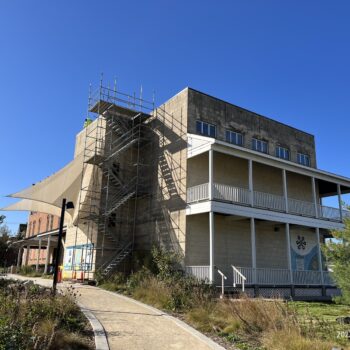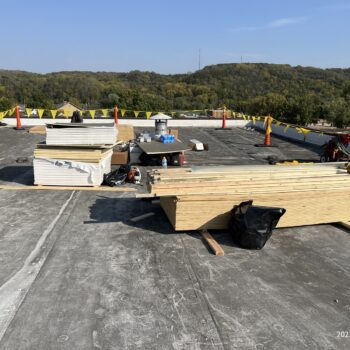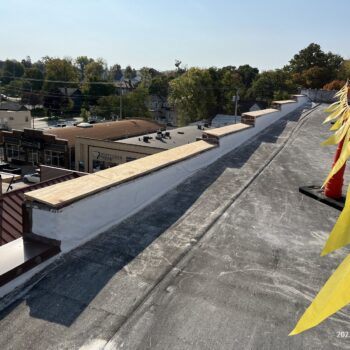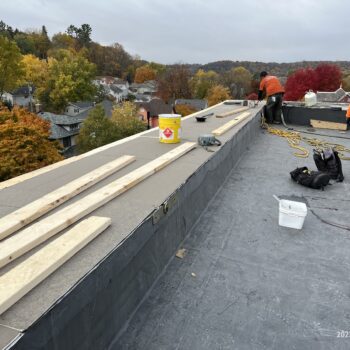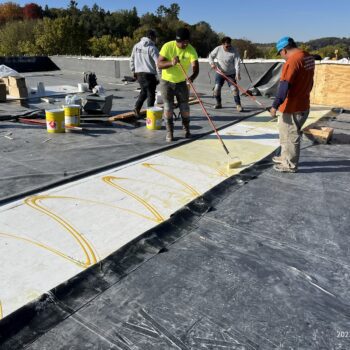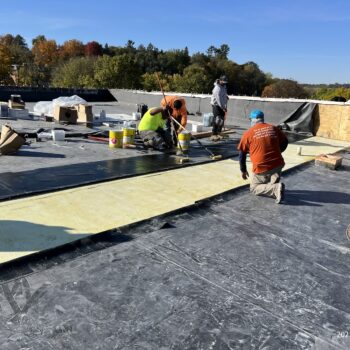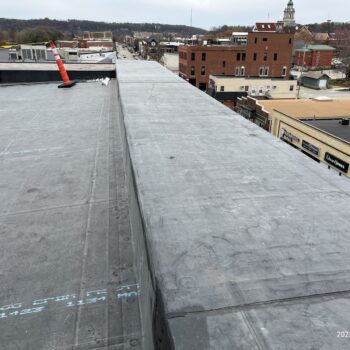Vesterheim recently replaced the roof on the museum’s Main Building—an important major project in protecting the museum collection. The primary goals were to help preserve the historic building and to improve climate control in the museum space.
The Project
The project began in 2021 when Lerch Bates, technical advisors based in the Twin Cities, assessed its condition and determined the 24-year-old roof had reached the end of its service life. Then in October and November 2023, ForSure Roofing from Des Moines, Iowa, completed the replacement.
The work included removing the existing roof system of thermoplastic polyolefin (TPO) single-ply membrane and installing a new fully adhered EPDM roof system. The modifications to the roof were extensive and included installing a self-adhered vapor barrier, increasing the thickness of the new insulation on top of the roof, sloping the roof to prevent standing water, connecting the original part of the building more effectively to the building additions, adding additional roof drains, and installing adhered 60-mil black EPDM membrane.
These improvements follow modern building enclosure practice, help meet current energy code R-value requirements, and prevent condensation on the underside of the roof deck and standing water on the roof.
The Ship Gallery
The project required the temporary closure of the Ship Gallery, which spans the height of three floors and is a highlight within the building.
The Ship Gallery includes several large artifacts, too large for any other gallery in the museum. The largest artifact is the sailboat, TradeWind. Hans and Harald Hamran, brothers from Valdres, Norway, sailed the ship to the United States in order to arrive at the Century of Progress Exposition in Chicago in August 1933.
The Tobiassen brothers in Flekkefjord, Norway, built the boat of spruce in 1932. They were suspicious, though, of the Hamrans’ request for a boat with lots of compartments. Only smugglers needed a boat with lots of compartments. After the boat was completed, the Hamrans explained their intention to sail to America. Reportedly, the Tobiassens were angry because if they had known of the dangerous voyage, they would have built the boat better and stronger. The Hamrans survived the voyage and set a record. TradeWind was the smallest sailing ship to cross the Atlantic Ocean at the time.
TradeWind was moved to Vesterheim’s Ship Gallery in 1934 and has been a favorite of visitors ever since.
See a 360 view of the Ship Gallery at vesterheim.org here.
Another large artifact in the Ship Gallery is the altar from the Norwegian Seamen’s Church in Brooklyn, New York. The altarpiece was believed to have been made by Torvald Thompson, a Norwegian immigrant and carpenter. The altar painting is a scene of the ascension of Christ by Norwegian painter Ole P. Balling, best known in the United States for a portrait of the abolitionist John Brown and a monumental scene of Civil War General Grant and his generals now at the National Portrait Gallery. Seamen’s churches were an important cultural and spiritual link for Norwegian visitors and immigrants in coastal communities of the United States.
For more about the Norwegian Seamen’s Church, read a Vesterheim magazine article here.
Other artifacts in the Ship Gallery include a Norwegian fishing boat and many fine art paintings depicting the sea.
Projects such as this roof replacement are vital to the museum campus and stewardship the collection, and they represent ongoing facilities and maintenance needs. Vesterheim is grateful to ForSure Roofing and Lerch Bates for their work on the roof replacement and helping to preserve this important historic building.
The pictures below show the work in progress.

